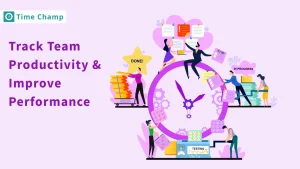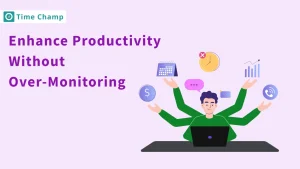Keeping an eye on your employee performance is very important to gain insights into how well the task is being completed and how efficiently the team is working. This is where an employee performance tracking system comes into play. An employee performance tracking system can help you measure these outcomes easily and identify patterns in your team’s performance.
As technology advances, so do the tools available for monitoring and tracking employee performance. However, not all of these tools are equally effective. Some may offer limited insights, while others may provide inaccurate information about your team’s performance. This can make it difficult to choose the right software to effectively track and monitor employee performance in your business.
Let’s dive into the best ways
to track your employee performance
and let’s discuss some of the best
tools available in the market which
can efficiently track your
team’s performance.
What is Employee Performance Tracking?
Employee performance tracking is a way for organizations to keep an eye on how well their employees are doing their jobs. It involves gathering and reviewing information about how well employees work, whether they meet goals, and their behavior at work.
Employee performance tracking can happen through regular check-ins with supervisors, using software to monitor work activities, or through formal performance reviews. Its aim is to help employees improve, acknowledge their accomplishments, and ensure they meet company expectations.
Traditional Performance Monitoring Methods
Before introducing all of these performance monitoring tools businesses used traditional tracking and monitoring methods to evaluate employee performance.
Let’s take a look at some of the traditional performance monitoring methods.
Annual Performance Reviews
- Employees meet with supervisors to discuss performance over the past year
- Supervisors provide feedback on strengths and areas for improvement
- Goals are set for the upcoming year
Regular Check-Ins
- Weekly, bi-weekly, or monthly meetings between employees and supervisors
- Feedback on recent work and discussion of challenges
- Setting goals for the future
Informal Feedback Sessions
- Casual feedback sessions can happen at any time
- Supervisors provide feedback on specific projects or tasks
- General guidance on improving performance
Focus on Regular Feedback
- Providing employees with consistent feedback on their performance
- Spotting areas for improvement and defining goals
- Assessing performance over time
One-on-One Meetings
- private discussions between an employee and their supervisor.
- covers performance, feedback, goals, and challenges.
- Improves communication, clarifies expectations, and boosts engagement.
Why Employee Performance Monitoring Software are Better than Traditional Methods
Employee Monitoring Software offers more accurate insights into employee performance by tracking their task completion and goal achievement rates.
Here are some of the features that help in evaluating employee performance.
-
Task Completion: The software tracks how many tasks or projects employees complete within a given time frame. It can also monitor the quality of work completed, including abidance to deadlines and meeting project requirements.
-
Time Tracking: This feature effortlessly monitors the time employees spend on different tasks, projects, or activities. This helps in assessing productivity and efficiency, highlighting areas where time management improvements can be made.
-
Attendance: The software can track employee attendance and punctuality, providing insights into their reliability and commitment to work schedules. This information helps in addressing attendance issues quickly.
-
Productivity Levels: By analyzing the amount of work completed in comparison to the time spent, the software can assess employee productivity levels. This data helps in identifying high-performing employees and those who may need additional support or training.
-
Goal Achievement: This feature helps in tracking the progress towards goals and objectives set for employees, helping to measure their performance against targets. This feature is helpful in encouraging employees to stay focused and motivated to achieve their goals.
-
Quality of Work: Some software can evaluate the quality of work based on predetermined standards or feedback from supervisors and peers. This helps ensure that employees are producing work that meets the required standards.
-
Behavior and Engagement: It analyses employee behavior and engagement, such as participation in meetings or collaboration with team members, and adherence to company policies. This information can be used to identify areas for improvement and recognize outstanding behavior.
-
Feedback and Reviews: Employee performance monitoring software includes features for providing feedback and conducting performance reviews. These tools help in facilitating open communication between employees and supervisors, leading to continuous improvement and development.
Employee monitoring software provides several advantages over traditional methods, such as real-time monitoring, enhanced accuracy, objective data, improved productivity, heightened security, remote work monitoring, cost-effectiveness, and compliance assurance.
These benefits make it an invaluable tool for managing and enhancing employee performance in modern workplaces.
Ways to Track Employee Performance
Tracking employee performance using
an employee performance tracker
offers various insights and a
different range of
benefits.
Here are some of the
ways to track employee performance.
- Goal Setting and Tracking: Performance tracking software enables users to set SMART (Specific, Measurable, Achievable, Relevant, Time-bound) goals for employees. You can easily track your employee’s progress toward these goals and receive notifications when milestones are reached or deadlines are approaching.
- Task Management: The software enables you to assign tasks to employees and track their progress. You can see which tasks are completed, in progress, or overdue, which helps you in managing workloads and deadlines effectively.
- Time Tracking: Performance tracking software includes time-tracking capabilities that enable employees to monitor the hours they spend on various tasks or projects. This helps in monitoring productivity and ensures accurate billing for client projects.
- Attendance Monitoring: Some performance tracking software includes attendance monitoring features that track when employees clock in and out. This helps you manage employee schedules and identify attendance issues.
- Feedback and Reviews: The software provides a platform for providing and receiving feedback. Employees can request feedback from supervisors or peers, and supervisors can provide feedback based on their performance. This supports a culture of constant improvement.
- Performance Reviews: Performance tracking software enables the performance review process. This enables you to easily schedule and conduct performance reviews within the software, document key points, and set achievable goals for the future.
- 360-Degree Feedback: The software allows users to collect feedback from multiple sources, including supervisors, peers, and subordinates. This gives a more complete picture of an employee’s performance.
- Analytics and Reporting: Performance tracking software generates analytics and reports based on employee data. You can use these insights to identify trends, track performance over time, and make fact-based decisions.
- Employee Development: The software enables you to identify areas where employees might need additional training or development. You can create customized development plans and track progress towards development goals.
- Compliance Monitoring: Performance tracking software can help ensure compliance with company policies and regulations. You can track employee abidance to policies and identify any compliance issues.
Best Employee Performance Tracking Software
There are many employee monitoring and performance tracking tools available out there but you should look for a tool with all the features that can help you seamlessly track your employee performance and is tailored to your needs.
Here are some of the best employee performance solutions for tracking and monitoring your employee performance accurately.
1. Time Champ
Time Champ is a top Employee performance tracking software that effectively monitors and tracks employee performance and generates automatic reports based on your company’s custom settings.
Time Champ captures attendance automatically, eliminating the need for manual tracking and ensuring accurate records.
You can view employee working time, idle time, and non-working time in the detailed reports, you can also view which websites and applications your employee has visited and for how long they stayed. These reports are categorized into productive, non-productive and neutral applications. You can customize every setting based on your company’s needs.
You can view how efficiently an employee works and find out employee behaviour and work patterns. You can easily get insights into every activity of your employee, these insights are essential for comparing and measuring employee performance.
You can set goals based on your employee capabilities and achieve company goals in the desired time.
You can also set up employee appreciation events to appreciate the employees who are working above the bar to reach company goals. This motivates employees and boosts work efficiency.
Time Champ also includes many features like location tracking, audio tracking, screenshots and screen recordings, all of which contribute to enhancing employee productivity and accountability.
Pricing
- Free Trail: Access Test Time Champ’s time-saving features with no hidden fees.
- Starter: $3.9 /user/month, ideal for individuals or small teams.
- Professional: $6.9/user/month, offers advanced functionality for improved task management.
- Enterprise: $13.9/user/month, featuring multiple functions tailored to meet enterprise needs.
Ratings
- G2 Rating: 4.8/5
- Capterra Rating: 4.9/5
2. Insightful
Insightful is another platform that focuses on enhancing employee productivity .It automatically identifies productive and unproductive time, allowing employees to concentrate better. Moreover, it analyses tasks and processes to help teams manage their resources more efficiently, ultimately improving performance and results.
Its user-friendly interface and intuitive features make it easy for teams to track their productivity and make informed decisions to enhance their work efficiency.
Pricing
- Basic plan starts at $6.40/user/month
Ratings
- G2 Rating: 4.7/5
- Capterra Rating: 4.7/5
3. Time Doctor
Time Doctor is a time-tracking and productivity tool that helps individuals and teams manage their time effectively. It offers features like time tracking, task management, and employee monitoring to improve productivity and efficiency.
By using Time Doctor, users can easily monitor their time usage, manage tasks effectively, and keep track of their team’s performance, making it a valuable tool for improving overall productivity.
Pricing
- Basic plan starts at $5.9/user/month
Ratings
- G2 Rating: 4.4/5
- Capterra Rating: 4.6/5
4. ActivTrak
ActivTrak is a software tool designed to enhance workforce productivity and enable organizations to gain insights into their employees’ work habits and patterns. It provides insights into how employees spend their time on the computer, which applications and websites they use most frequently, and how productive they are during work hours.
ActivTrak offers features such as real-time monitoring, productivity evaluation, and customizable reports to help organizations track and analyze employee performance.
Pricing
- Basic plan starts at $10/user/month
Ratings
- G2 Rating: 4.4/5
- Capterra Rating: 4.6/5
5. Hubstaff
Hubstaff is a thorough remote workforce management solution, that provides tools for time tracking, activity monitoring, and productivity analysis. It offers features such as time tracking, activity monitoring, and productivity analysis to track how employees spend their time and ensure they are working efficiently.
Hubstaff also provides tools for managing tasks, tracking expenses, and generating reports, making it a comprehensive solution for remote team management.
Pricing
- Basic plan starts at $4.99/user/month
Ratings
- G2Rating: 4.3/5
- Capterra Rating: 4.6/5
Conclusion
In conclusion, tracking employee performance gives in-depth and accurate insights into employee productivity and overall performance. These simple tools offer transparent and accurate insights into your employee performance metrics, but choosing the right performance and productivity tracking software that fits your company’s needs and requirements is essential.
Also Read
Top 5 Factors Affecting Productivity In the Work Environment
The 10 Best Employee Time Tracking Software
Ways to Use Productivity Intelligence to Improve Team Performance
Employee performance tracking involves monitoring and evaluating employee’s work activities, behaviors, and outcomes to assess their effectiveness and contribution to organizational goals.
Examples of easy employee performance tracking methods include using time tracking software, setting and monitoring goals, conducting regular check-ins and feedback sessions, and using employee surveys to gather feedback.
Easy employee performance tracking methods can benefit your organization by improving productivity, identifying top performers, recognizing areas for improvement, and enhancing overall performance and efficiency.
To choose the right tracking method, consider your organization’s goals, the size of your team, and the type of work they do. Look for tools that are user-friendly, offer the features you need, and fit your budget.
The frequency of tracking can vary depending on your organization’s needs. Some companies track performance on a daily or weekly basis, while others may opt for monthly or quarterly reviews. It’s important to find a schedule that works for your team and allows for regular feedback and improvement.
Yes, tracking and monitoring methods that promote transparency and accountability can improve team collaboration. By clearly defining goals and expectations, team members can work together more effectively and support each other in achieving shared objectives.
To ensure fairness, establish clear criteria for evaluating performance and apply them consistently across all employees. Avoiding favoritism and providing regular feedback can also help maintain fairness in the tracking process.
If employees are resistant, it’s important to communicate the benefits of tracking their performance and address any concerns they may have. Involve employees in the process and listen to their feedback to ensure that the tracking methods are effective and well-received.





